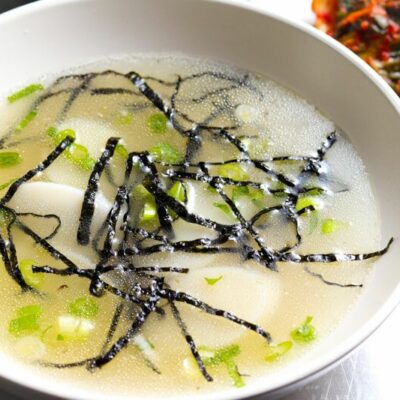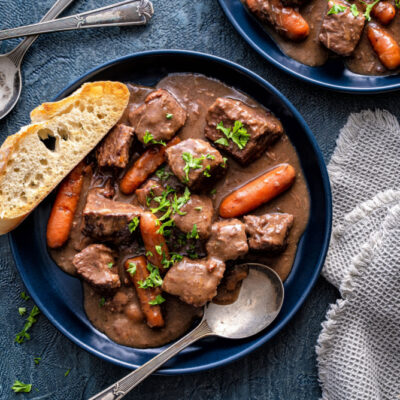
Soup is versatile and delicious. It’s the perfect meal for a cold winter’s day or as a light entree to a heavy meal. There are plenty of tasty and comforting types of soup to choose between, including light broth-based soups, creamy soups, hearty soups, and even cold soups.
That’s not even considering the varied ingredients you can put into your soup. Do you want a vegetarian option or something meat-heavy? What about fresh herbs and spices? You might even be debating whether to make the soup yourself or get some delivered instead.
Whatever your choice, it’s worth learning how to freeze soup. After all, most soup recipes give you a decent amount of soup, often between six or eight servings at a time. This is great when you’re feeding a crowd, but leads to tons of leftovers if you’re just making soup for one or two.
Freezing soup is as simple as allowing it to cool, dishing it into appropriate containers, and placing it in the freezer. However, there are a few extra things to consider, especially as some types of soup freeze much better than others.
P.S. Freezing soup has other benefits too. You can easily portion and freeze the soup so that you have ready to go lunches. The soup is also great on nights when you don’t want to think about dinner.
How To Freeze Soup

Soup often freezes well, with little difference between the freshly made soup and the thawed version. You don’t need any special equipment either, just the cooled soup and some freezer safe containers.
The Basic Approach
The steps for freezing soup are basic and pretty obvious.
First, make sure the soup is cool. If it was freshly prepared, try placing the pot of soup in an ice bath to help it cool faster.
Once the soup is cool, you can transfer it to an appropriate container. Some people use solid containers here, while others stick to freezer safe bags instead. Both styles work well, so it’s simply a matter of choosing what works for you.
Don’t fill the container up completely. You’ll need to leave a little space for expansion.
Regardless of your choice, make sure you label the container well. Include the date you made the soup, plus details about the type of soup and serving size. This is especially important if you freeze soup regularly or if you make similar soups with minor variations.
Remember, different dishes can look very similar once they’ve been frozen. It’s also difficult to recall what was in a particular container when you froze it months ago. If you don’t label your soup, you could easily lose track of some of it and leave it in the freezer for far too long.
How To Portion Your Soup

Instead of freezing a large brick of soup, why not portion it out into individual serving sizes? This makes the soup much easier to use later and doesn’t require much extra work. There are multiple approaches you can try here, including the following.
Freeze In Plastic Cups
Plastic cups are a simple way to get the right serving size. You simply fill them to the desired level and place them in the freezer until the soup is completely frozen.
Then, you can remove your soup from the cups and place the frozen blocks in resealable freezer bag. You could use individual freezer bags here or simply use a single large bag for all the soup blocks.
If the cups were of decent quality, running a little hot water over the outside of the cup should be enough to unstick the soup from the cup, allowing you to remove it without an issue. Some bloggers intentionally choose cheap low quality cups instead, so they can simply break the cup to remove it.
Use Zip Lock Bags
Small resealable freezer bags can be easily used for soup. One approach is to place the bag in a cup, fill it with the appropriate amount of soup, seal it, and then lay the bag flat for freezing.
This approach allows you to get a flat bag of soup without much mess. Not only are these bags easy to use, but they also take up barely any space in the freezer.
Use Muffin Pans Or Ice Cube Trays
You can also freeze soup in muffin pans or large ice cube trays. Some companies have even created large silicone freezer trays that are designed for freezing soup and similar foods. These give you the perfect serving size with minimal effort.
Here, the first step is to pour the soup into the muffin pans or ice cube trays and then place these in the freezer. Once the soup is frozen, it can be gently removed from the container and placed in a labeled freezer safe bag.
Then, you can simply remove individual servings of soup when it’s time to use them.
Soups That Freeze Well

As you’ve probably guessed, soups don’t all freeze the same. Some types respond well to freezing and are just as good as when they were fresh. Others don’t turn out well at all. The soups below fall into the first category, so you can freeze them without any concerns.
Broth-Based
Broth-based soups freeze well and their texture doesn’t change much after freezing and thawing. This is particularly true for bone broth soups and similar, as these don’t have many extra ingredients.
Some heartier versions will freeze well too, including broth-based soups with lentils and those with vegetable pieces.
Bean And Lentil Soups
Beans and lentils both hold up surprisingly well after freezing. They do become a little softer, but this is often barely noticeable in the finished soup.
Pureed Soups
Pureed soups, including tomato soup, butternut squash soup, and similar options, tend to freeze and thaw well. Just ensure these don’t rely heavily on dairy, as dairy doesn’t behave as well in the freezer.
Meaty Soups
We can’t forget meat, either. It may become a little more tender after thawing, but as with beans, the effect isn’t that noticeable.
Hearty Soups And Stews
Finally, we have hearty soups, like chili and beef-based soups. As long as these don’t include dairy, these all tend to freeze well and taste just as good the second time round.
In fact, these types of soup are some of the best for freezing and retain their quality well. The same principles apply to stews too. After all, stews are basically just soups with less liquid.
Soups To Be Cautious With

The following soups are all a little more challenging. You’ll often need to separate out one or more ingredients before freezing the soup.
Soups With Pasta Or Grains
This category includes soups with rice, pasta, or alternative grains like barley. These grain-based ingredients all become mushy after thawing, making them much less appealing. The starch in these ingredients is problematic too, messing with the texture of your soup.
The best way around this is to freeze the soup before adding these ingredients. Then, you can simply cook and add whichever ingredient when reheating the soup.
If you want an all-in-one solution, try undercooking the rice or pasta. This way, the ingredients shouldn’t overcook as you’re reheating the soup.
However, this is a less precise solution. Your soup will be better if you add the ingredients after reheating the soup, rather than undercooking them.
Potato-Heavy Soups
Regular potatoes don’t freeze well in soup, as they end up with a strange and somewhat gummy texture.
The best way around this is to use blended potato rather than potato chunks. You might still get an odd texture, but this can be fixed by blending the soup once it’s thawed.
Thankfully, sweet potato soups are a different story and freeze better. Still, even here, it’s best to blend your sweet potatoes rather than including large chunks.
Creamy Soups
Many creamy soups don’t freeze well either. Dairy is the biggest reason for this issue, as it tends to split and become grainy as the soup thaws. Blending or vigorously whisking the soup can help with the texture, but it still won’t be the same as before it was frozen.
You might be okay if the soup only uses a tiny amount of dairy. But, if dairy is a key ingredient, it’s best to avoid freezing the soup. Some other creamy soups freeze poorly too, including those made using blended nuts and seeds, or many types of non-dairy milk.
There are some exceptions. If your soup mostly gets its creaminess from blended vegetables, then it should respond fine to freezing and thawing. The same is true for soups that rely on coconut milk.
Vegetable-Heavy Soups
Vegetable soups can freeze and reheat well, but only if you are careful when you make the soup. Notably, the process of reheating your soup risks overcooking the vegetables, making them mushy and unappealing.
The best solution is to slightly undercook your vegetables. They’ll finish cooking as you reheat your soup, giving you the perfect texture.
Seafood Soups
Finally, we have seafood soups, including those with shellfish and those with fish. The seafood often becomes tough after thawing, while some of the flavors change as well.
The main way around the issue is to freeze the broth on its own, then add fresh seafood when reheating it. However, doing so mightn’t be worth the effort. It’s much better to simply enjoy the seafood soup when you first prepare it.
How To Thaw And Reheat Soup

Ideally, soup should be thawed in the fridge, as the low temperature slows down the thawing process and helps with the texture of your soup. Once the soup is thawed, it can be easily reheated on the stovetop or in the microwave.
However, this approach doesn’t always work, especially if you’re using soup as a last minute meal.
The stovetop is the best choice if you want to reheat your frozen soup directly. Start the process by adding a little water or broth to your pot, then your lump of frozen soup. The liquid creates steam which helps your soup to thaw well.
Take things slowly as you reheat the soup. This gives you the best texture and ensures you don’t burn your meal in the process.
You’ll need a little water for reheating in the microwave too. Here, you’ll need to stop and stir the soup regularly to ensure it defrost and reheats evenly.
Once the soup is mostly reheated, you can add a little lemon juice, fresh herbs, or olive oil. These ingredients all provide a fantastic pop of flavor and make the soup taste even better.
Things To Consider
Don’t Freeze Your Soup For Too Long
The best practice is to freeze your soup for no longer than 2 to 3 months. While this isn’t a long time, it’s the best window for quality.
Most soups are still safe to eat after this point, so you can easily leave them in the freezer for six to eight months or even longer. However, quality does gradually decline and the flavors become more muted as you go.
This is why it’s so important to label your soup well. Doing so makes it easy to use your soup while it still tastes good.
Also, on that note, it helps to rotate the items in your freezer. This way, your soup doesn’t get buried and forgotten in the back.
Check For Quality
It’s always worth checking for quality indicators, doubly so if your soup has been in the freezer for more than six months.
Pay attention to the color, smell, and texture of the soup as it thaws. Notably, off odors, sliminess, and sour flavors are all signs that the soup mightn’t be safe to eat.
The one exception is freezer burn, which is where the soup looks icy and whitish on the edges. This issue affects the quality and flavor of your soup, but doesn’t make it unsafe.
Don’t Refreeze
You can freeze, thaw, and reheat soup once without a problem, but doing so a second time doesn’t work well. Trying to do so almost always decreases the flavor and texture of the soup, making it much less appealing.
In fact, all of the issues we’ve mentioned in this article become much more noticeable after a second freeze-thaw cycle. Freezing and thawing the soup a second time also presents food safety issues, increasing the risk of food poisoning from your soup. Honestly, doing so just isn’t worth it.
Other Ways To Preserve Soup
Canning
If you don’t want to freeze soup – canning is the way to go. Notably, we’re talking about pressure canning here, as soup can’t be safely canned using the water bath technique.
However, canning doesn’t work well for all types of soup. It’s best to avoid ingredients like pasta, rice, cream, and thickening agents, because these all affect heat penetration and may make your canned soup unsafe.
This means that creamy soups and carb-heavy soups often can’t be safely canned at home. If you’re unsure, take the time to research the specific type of soup you’re considering and find a recipe that’s been developed for canning.
In all cases, be sure to take the appropriate food safety steps. After all, you’re looking for a delicious soup, not something that will make you sick.
Dehydrating
Soup can actually be prepared and then dehydrated, giving you a shelf-stable meal that just needs to be reconstituted.
One technique is to blend a thick soup and then use a dehydrator to dry it. Once the soup has dried, it can be ground into a powder. This powder can then easily be rehydrated with hot water.
Alternatively, you might focus on dehydrating individual ingredients, like vegetables, then combine these with seasoning and when it is time to rehydrate. There are a variety of other techniques as well, some of which use a combination of dried and fresh ingredients.
Regardless, drying soup is somewhat complicated. The best approaches vary depending on the type of soup and some soups will dehydrate much better than others. You’ll need to plan carefully to make sure your soup can be preserved in this way.

















 Can You Eat Raw Mushrooms?
Can You Eat Raw Mushrooms?